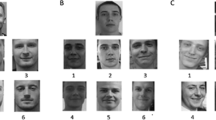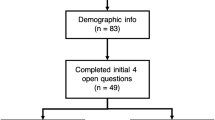Abstract
Although sensory problems, including unusual tactile sensitivity, are heavily associated with autism, there is a dearth of rigorous psychophysical research. We compared tactile sensation in adults with autism to controls on the palm and forearm, the latter innervated by low-threshold unmyelinated afferents subserving a social/affiliative submodality of somatosensation. At both sites, the groups displayed similar thresholds for detecting light touch and innocuous sensations of warmth and cool, and provided similar hedonic ratings of the pleasantness of textures. In contrast, increased sensitivity to vibration was seen in the autism group on the forearm, along with increased sensitivity to thermal pain at both sites. These findings suggest normal perception along with certain areas of enhanced perception in autism, consistent with previous studies.









Similar content being viewed by others
References
American Psychiatric Association. (2000). DSM-IV-TR diagnostic and statistical manual of mental disorders (4th ed.)—Text revision. Washington, DC, USA: American Psychiatric Association.
Baranek, G. T. (1999). Autism during infancy: A retrospective video analysis of sensory-motor and social behaviors at 9–12 months of age. Journal of Autism and Developmental Disorders, 29, 213–224.
Baranek, G. T. (2002). Efficacy of sensory and motor interventions for children with autism. Journal of Autism and Developmental Disorders, 32, 397–422.
Baranek, G. T., David, F. J., Poe, M. D., Stone, W. D., & Watson L. R. (2006). Sensory experiences questionnaire: Discriminating sensory features in young children with autism, developmental delays, and typical development. Journal of Child Psychology and Psychiatry, 47, 591–601.
Bensmaia, S. J., Leung. Y. Y., Hsiao, S. S., & Johnson, K. O. (2005). Vibratory adaptation of cutaneous mechanoreceptive afferents. Journal of Neurophysiology, 94, 3023–3036.
Bertone, A., Mottron, L., Jelenic, P., & Faubert, J. (2003). Motion perception in autism: A “complex” issue. Journal of Cognitive Neuroscience, 15, 218–225.
Blakemore, S. J., Tavassoli, T., Calo, S., Thomas, R. M., Catmur, C., Frith, U., et al. (2006). Tactile sensitivity in Asperger syndrome. Brain and Cognition, 61, 5–13.
Dunn, W. (2001). The sensations of everyday life: Empirical, theoretical, and pragmatic considerations. American Journal of Occupational Therapy, 55, 608–620.
Dunn, W., Myles, B. S., & Orr, S. (2002). Sensory processing issues associated with Asperger syndrome: A preliminary investigation. American Journal of Occupational Therapy, 56, 97–102.
Elbert, T., Pantev, C., Wienbruch, C., Rockstroh, B., & Taub, E. (1995). Increased cortical representation of the fingers of the left hand in string players. Science, 270(5234), 305–307.
Essick, G. K. (1992). Comprehensive clinical evaluations of perioral sensory function. Oral and Maxillofacial Surgery Clinics of North America, 4, 503–526.
Fruhstorfer, H., Lindblom, U., & Schmidt, W. G. (1976). Method for quantitative estimation of thermal thresholds in patients. Journal of Neurology, Neurosurgery, and Psychiatry, 39, 1071–1075.
Goble, A. K., & Hollins, M. (1993). Vibrotactile adaptation enhances amplitude discrimination. Journal of the Acoustical Society of America, 93, 418–424.
Grandin, T. (1992). An inside view of autism. In E. Schopler, & G. B. Mesibov (Eds.), High functioning individuals with autism. (pp. 105–126). New York: Plenum.
Grandin, T. (2000). My experiences with visual thinking, sensory problems, and communication difficulties. Available online: http://www.autism.org/temple/visual/html.
Gusella, J. L., Muir, D. W., & Tronick, E. Z. (1988). The effect of manipulating maternal behavior during an interaction on 3- and 6-month-olds; affect and attention. Child Development, 59, 1111–1124.
Hollins, M., Sigurdsson, A., Fillingim, L., & Goble, A. K. (1996). Vibrotactile threshold is elevated in temporomandibular disorders. Pain, 67, 89–96.
Iarocci, G., & McDonald, J. (2006). Sensory integration and the perceptual experience of persons with autism. Journal of Autism and Developmental Disorders, 36, 77–90.
Jääskeläinen, S. (2004). Clinical neurophysiology and quantitative sensory testing in the investigation or orofacial pain and sensory function. Journal of Orofacial Pain, 18, 85–107.
Johansson, R. S., & Vallbo, A. B. (1979). Tactile sensibility in the human hand: Relative and absolute densities of four types of mechanoreceptive units in the glabrous skin. Journal of Physiology (London), 286, 283–300.
Joliffe, T., & Baron-Cohen, S. (1997). Are people with autism or Asperger’s syndrome faster than normal on the embedded figures task? Journal of Child Psychology and Psychiatry, 38, 527–534.
Jones, R. P., Quigney, C., & Huws, J. C. (2003). First-hand accounts of sensory perceptual experiences in autism: A qualitative analysis. Journal of Intellectual and Developmental Disability, 28, 112–121.
Kakuda, N. (1992). Conduction velocity of low-threshold mechanoreceptive afferent fibers in the glabrous and hairy skin of human hands measured with microneurography and spike-triggered averaging. Neuroscience Research, 15, 179–188.
Kern, J. K., Trivedi, M. H., Garver, C. R., Grannemann, B. D., Andrews, A. A., Savla, J. S., et al. (2006). The pattern of sensory processing abnormalities in autism. Autism, 10, 480–494.
LeCouteur, A., Lord, C., & Rutter, M. (2003). Autism diagnostic interview-revised (ADI-R). Los Angeles: Western Psychological Corporation.
Lord, C., Rutter, M., Dilavore, P., & Risi, S. (1999). The autism diagnostic observation schedule (ADOS). Los Angeles: Western Psychological Corporation.
Lundstrom, R., & Johansson, R. S. (1986). Acute impairment of the sensitivity of skin mechanoreceptive units caused by vibration exposure of the hand. Ergonomics, 29(5), 687–698.
Merzenich, M. M., & Jenkins, W. M. (1993). Reorganization of cortical representations of the hand following alterations of skin inputs induced by nerve injury, skin island transfers, and experience. Journal of Hand Therapy, 6, 89–104.
Milne, E., Swettenham, J., Hansen, P., Campbell, R., Jeffries, H., & Plaisted, K. (2002). High motion coherence thresholds in children with autism. Journal of Child Psychology and Psychiatry, 43, 255–263.
Mottron, L., & Burack, J. A. (2001). Enhanced perceptual functioning in the development of autism. In J. A. Burack, T. Charman, N. Yimiya, & P. R. Zelazo (Eds.), The development of autism: Perspectives from theory and research. New Jersey: Lawrence Erlbaum.
Mottron, L., Burack, J. A., Iarocci, G., Bellewill, S., & Enns, J. T. (2003). Locally oriented perception with intact global processing among adolescents with high-functioning autism: Evidence from multiple paradigms. Journal of Child Psychology and Psychiatry, 44(6), 904–913.
Mottron, L., Peretz, I., & Menard, E. (2000). Local and global processing of music in high-functioning persons with autism: Beyond central coherence? Journal of Child Psychology and Psychiatry, 41(8), 1057–1065.
Olausson, H., Lamarre, Y., Backlund, H., Wallin, B. G., Starck, G., Ekholm, S., et al. (2002). Unmyelinated tactile afferents signal touch and project to insular cortex. Nature Neuroscience, 5(9), 900–904.
O’Riordan, M., & Passetti, F. (2006). Discrimination in autism within different sensory modalities. Journal of Autism and Developmental Disorders, 36, 665–675.
Ragin, Y. K. (2002). Development and testing of a psychophysical protocol for studies on the affective components of touch. Masters thesis at the University of North Carolina, Chapel Hill.
Rogers, S. J., Hepburn, S., & Wehner, W. (2003). Parent reports of sensory symptoms in toddlers with autism and those with other developmental disorders. Journal of Autism and Developmental Disorders, 33, 633–642.
Rogers, S. J., & Ozonoff, S. (2005). Annotation: What do we know about sensory dysfunction in autism? A critical review of the empirical evidence. Journal of Child Psychology and Psychiatry, 46(12), 1255–1268.
Roggman, L. A., & Woodson, R. (1989). Touch and gaze in parent-infant play. Poster presented at the Society for Research in Child Development Conference, Kansas City.
Shah, A., & Frith, U. (1983). An islet of ability in autism: A research note. Journal of Child Psychology and Psychiatry, 24, 613–620.
Shah, A., & Frith, U. (1993). Why do autistic individuals show superior performance on the block design test? Journal of Child Psychology and Psychiatry, 34, 1351–1364.
Stack, D. M., & Muir, D. W. (1990). Tactile stimulation as a component of social interchange: New interpretations for the still-face effect. British Journal of Developmental Psychology, 8, 131–145.
Stack, D. M., & Muir, D. W. (1992). Adult tactile stimulation during face-to-face interactions modulates five-month-olds’ affect and attention. Child Development, 63, 1509–1525.
Sterr, A., Muller, M. M., Elbert, T., Rockstroh, B., Pantev, C., & Taub, E. (1998). Perceptual correlates of changes in cortical representation of fingers in blind multifinger Braille readers. Journal of Neuroscience, 18(11), 4417–4423.
Vallbo, A. B., Olausson, H., & Wessberg, J. (1999). Unmyelinated afferents constitute a second system coding tactile stimuli of the human hairy skin. Journal of Neurophysiology, 81, 2753–2763.
Wessberg, J., Olausson, H., Fernstrom, K. W., & Vallbo, A. B. (2003). Receptive field properties of unmyelinated tactile afferents in the human skin. Journal of Neurophysiology, 89, 1567–1575.
Whitsel, B. L., Kelly, E. F., Quibrera, M., Tommerdahl, M., Li, Y., Favorov, O., et al. (2003). Time-dependence of SI RA neuron response to cutaneous flutter stimulation. Somatosensory and Motor Research, 20, 45–69.
Zwislocki, J., Maire, F., Feldman, A. S., & Rubin, H. (1958) On the effect of practice and motivation on the threshold of audibility. Journal of the Acoustical Society of America, 30, 254–262.
Acknowledgments
The authors thank the participants and their families, and the University of North Carolina Autism Research Registry. This work was partially supported by NIH grants R01-HD42168 (awarded to G.B.) and NS045685 (awarded to G.E.), funds available from F. McGlone (Unilever R&D Port Sunlight), and a grant from the Foundation of Hope for Research and Treatment in Mental Illness (awarded to K.P). Dr Pelphrey is supported by NIMH grant K01-MH01725, and a John Merck Scholar’s Award. Dr Cascio is supported by training grants T32-HD040127-04 (PI: Joseph Piven) and T32-MH019111-15 (PI: John Gilmore).
Author information
Authors and Affiliations
Corresponding author
Rights and permissions
About this article
Cite this article
Cascio, C., McGlone, F., Folger, S. et al. Tactile Perception in Adults with Autism: a Multidimensional Psychophysical Study. J Autism Dev Disord 38, 127–137 (2008). https://doi.org/10.1007/s10803-007-0370-8
Received:
Accepted:
Published:
Issue Date:
DOI: https://doi.org/10.1007/s10803-007-0370-8




